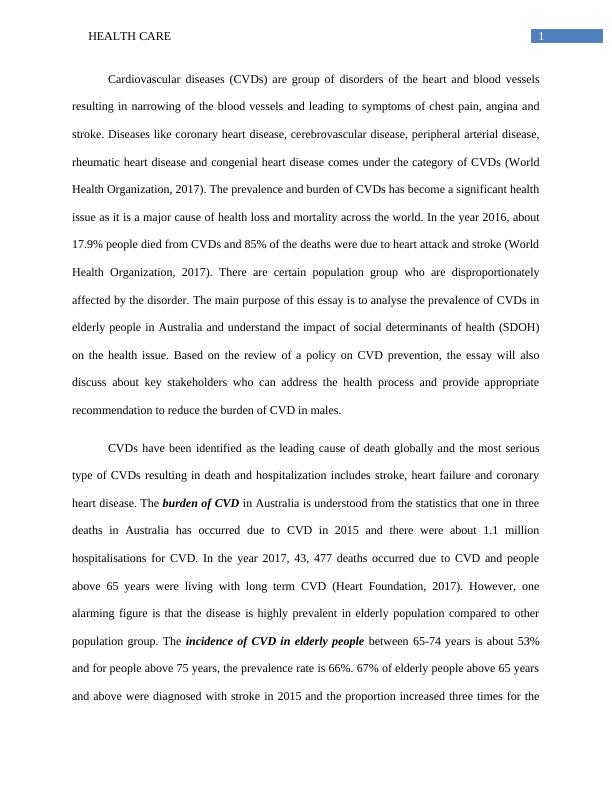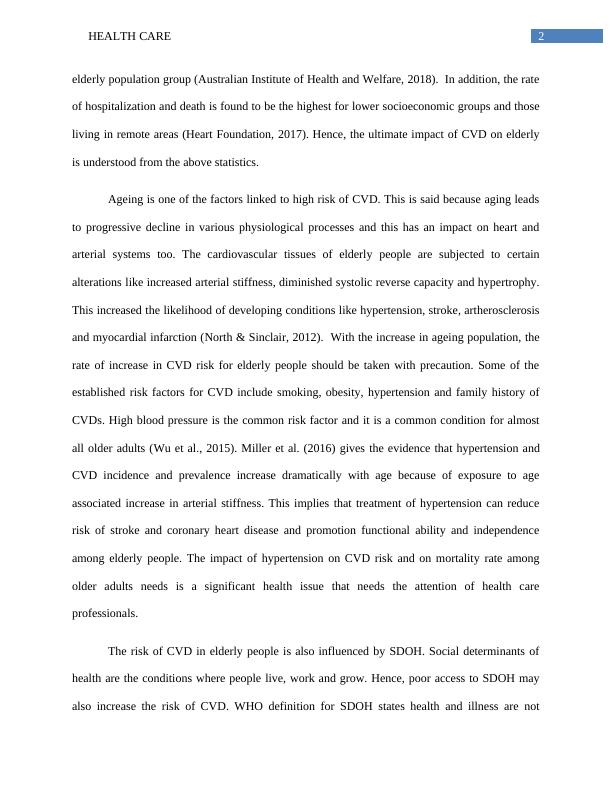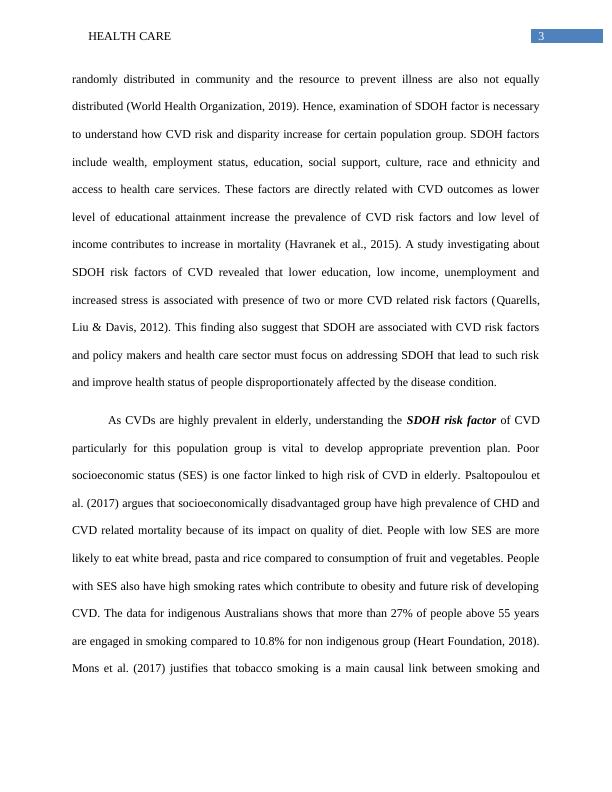Prevalence of Cardiovascular Diseases in Elderly People in Australia
15 Pages3653 Words295 Views
Added on 2023-04-04
About This Document
This essay analyzes the prevalence of cardiovascular diseases (CVDs) in elderly people in Australia and explores the impact of social determinants of health (SDOH) on the health issue. It also discusses key stakeholders who can address the health process and provides recommendations to reduce the burden of CVD in males.
Prevalence of Cardiovascular Diseases in Elderly People in Australia
Added on 2023-04-04
ShareRelated Documents
Running head: HEALTH CARE
Health care
Name of the student:
Name of the University:
Author’s note
Health care
Name of the student:
Name of the University:
Author’s note

1HEALTH CARE
Cardiovascular diseases (CVDs) are group of disorders of the heart and blood vessels
resulting in narrowing of the blood vessels and leading to symptoms of chest pain, angina and
stroke. Diseases like coronary heart disease, cerebrovascular disease, peripheral arterial disease,
rheumatic heart disease and congenial heart disease comes under the category of CVDs (World
Health Organization, 2017). The prevalence and burden of CVDs has become a significant health
issue as it is a major cause of health loss and mortality across the world. In the year 2016, about
17.9% people died from CVDs and 85% of the deaths were due to heart attack and stroke (World
Health Organization, 2017). There are certain population group who are disproportionately
affected by the disorder. The main purpose of this essay is to analyse the prevalence of CVDs in
elderly people in Australia and understand the impact of social determinants of health (SDOH)
on the health issue. Based on the review of a policy on CVD prevention, the essay will also
discuss about key stakeholders who can address the health process and provide appropriate
recommendation to reduce the burden of CVD in males.
CVDs have been identified as the leading cause of death globally and the most serious
type of CVDs resulting in death and hospitalization includes stroke, heart failure and coronary
heart disease. The burden of CVD in Australia is understood from the statistics that one in three
deaths in Australia has occurred due to CVD in 2015 and there were about 1.1 million
hospitalisations for CVD. In the year 2017, 43, 477 deaths occurred due to CVD and people
above 65 years were living with long term CVD (Heart Foundation, 2017). However, one
alarming figure is that the disease is highly prevalent in elderly population compared to other
population group. The incidence of CVD in elderly people between 65-74 years is about 53%
and for people above 75 years, the prevalence rate is 66%. 67% of elderly people above 65 years
and above were diagnosed with stroke in 2015 and the proportion increased three times for the
Cardiovascular diseases (CVDs) are group of disorders of the heart and blood vessels
resulting in narrowing of the blood vessels and leading to symptoms of chest pain, angina and
stroke. Diseases like coronary heart disease, cerebrovascular disease, peripheral arterial disease,
rheumatic heart disease and congenial heart disease comes under the category of CVDs (World
Health Organization, 2017). The prevalence and burden of CVDs has become a significant health
issue as it is a major cause of health loss and mortality across the world. In the year 2016, about
17.9% people died from CVDs and 85% of the deaths were due to heart attack and stroke (World
Health Organization, 2017). There are certain population group who are disproportionately
affected by the disorder. The main purpose of this essay is to analyse the prevalence of CVDs in
elderly people in Australia and understand the impact of social determinants of health (SDOH)
on the health issue. Based on the review of a policy on CVD prevention, the essay will also
discuss about key stakeholders who can address the health process and provide appropriate
recommendation to reduce the burden of CVD in males.
CVDs have been identified as the leading cause of death globally and the most serious
type of CVDs resulting in death and hospitalization includes stroke, heart failure and coronary
heart disease. The burden of CVD in Australia is understood from the statistics that one in three
deaths in Australia has occurred due to CVD in 2015 and there were about 1.1 million
hospitalisations for CVD. In the year 2017, 43, 477 deaths occurred due to CVD and people
above 65 years were living with long term CVD (Heart Foundation, 2017). However, one
alarming figure is that the disease is highly prevalent in elderly population compared to other
population group. The incidence of CVD in elderly people between 65-74 years is about 53%
and for people above 75 years, the prevalence rate is 66%. 67% of elderly people above 65 years
and above were diagnosed with stroke in 2015 and the proportion increased three times for the

2HEALTH CARE
elderly population group (Australian Institute of Health and Welfare, 2018). In addition, the rate
of hospitalization and death is found to be the highest for lower socioeconomic groups and those
living in remote areas (Heart Foundation, 2017). Hence, the ultimate impact of CVD on elderly
is understood from the above statistics.
Ageing is one of the factors linked to high risk of CVD. This is said because aging leads
to progressive decline in various physiological processes and this has an impact on heart and
arterial systems too. The cardiovascular tissues of elderly people are subjected to certain
alterations like increased arterial stiffness, diminished systolic reverse capacity and hypertrophy.
This increased the likelihood of developing conditions like hypertension, stroke, artherosclerosis
and myocardial infarction (North & Sinclair, 2012). With the increase in ageing population, the
rate of increase in CVD risk for elderly people should be taken with precaution. Some of the
established risk factors for CVD include smoking, obesity, hypertension and family history of
CVDs. High blood pressure is the common risk factor and it is a common condition for almost
all older adults (Wu et al., 2015). Miller et al. (2016) gives the evidence that hypertension and
CVD incidence and prevalence increase dramatically with age because of exposure to age
associated increase in arterial stiffness. This implies that treatment of hypertension can reduce
risk of stroke and coronary heart disease and promotion functional ability and independence
among elderly people. The impact of hypertension on CVD risk and on mortality rate among
older adults needs is a significant health issue that needs the attention of health care
professionals.
The risk of CVD in elderly people is also influenced by SDOH. Social determinants of
health are the conditions where people live, work and grow. Hence, poor access to SDOH may
also increase the risk of CVD. WHO definition for SDOH states health and illness are not
elderly population group (Australian Institute of Health and Welfare, 2018). In addition, the rate
of hospitalization and death is found to be the highest for lower socioeconomic groups and those
living in remote areas (Heart Foundation, 2017). Hence, the ultimate impact of CVD on elderly
is understood from the above statistics.
Ageing is one of the factors linked to high risk of CVD. This is said because aging leads
to progressive decline in various physiological processes and this has an impact on heart and
arterial systems too. The cardiovascular tissues of elderly people are subjected to certain
alterations like increased arterial stiffness, diminished systolic reverse capacity and hypertrophy.
This increased the likelihood of developing conditions like hypertension, stroke, artherosclerosis
and myocardial infarction (North & Sinclair, 2012). With the increase in ageing population, the
rate of increase in CVD risk for elderly people should be taken with precaution. Some of the
established risk factors for CVD include smoking, obesity, hypertension and family history of
CVDs. High blood pressure is the common risk factor and it is a common condition for almost
all older adults (Wu et al., 2015). Miller et al. (2016) gives the evidence that hypertension and
CVD incidence and prevalence increase dramatically with age because of exposure to age
associated increase in arterial stiffness. This implies that treatment of hypertension can reduce
risk of stroke and coronary heart disease and promotion functional ability and independence
among elderly people. The impact of hypertension on CVD risk and on mortality rate among
older adults needs is a significant health issue that needs the attention of health care
professionals.
The risk of CVD in elderly people is also influenced by SDOH. Social determinants of
health are the conditions where people live, work and grow. Hence, poor access to SDOH may
also increase the risk of CVD. WHO definition for SDOH states health and illness are not

3HEALTH CARE
randomly distributed in community and the resource to prevent illness are also not equally
distributed (World Health Organization, 2019). Hence, examination of SDOH factor is necessary
to understand how CVD risk and disparity increase for certain population group. SDOH factors
include wealth, employment status, education, social support, culture, race and ethnicity and
access to health care services. These factors are directly related with CVD outcomes as lower
level of educational attainment increase the prevalence of CVD risk factors and low level of
income contributes to increase in mortality (Havranek et al., 2015). A study investigating about
SDOH risk factors of CVD revealed that lower education, low income, unemployment and
increased stress is associated with presence of two or more CVD related risk factors (Quarells,
Liu & Davis, 2012). This finding also suggest that SDOH are associated with CVD risk factors
and policy makers and health care sector must focus on addressing SDOH that lead to such risk
and improve health status of people disproportionately affected by the disease condition.
As CVDs are highly prevalent in elderly, understanding the SDOH risk factor of CVD
particularly for this population group is vital to develop appropriate prevention plan. Poor
socioeconomic status (SES) is one factor linked to high risk of CVD in elderly. Psaltopoulou et
al. (2017) argues that socioeconomically disadvantaged group have high prevalence of CHD and
CVD related mortality because of its impact on quality of diet. People with low SES are more
likely to eat white bread, pasta and rice compared to consumption of fruit and vegetables. People
with SES also have high smoking rates which contribute to obesity and future risk of developing
CVD. The data for indigenous Australians shows that more than 27% of people above 55 years
are engaged in smoking compared to 10.8% for non indigenous group (Heart Foundation, 2018).
Mons et al. (2017) justifies that tobacco smoking is a main causal link between smoking and
randomly distributed in community and the resource to prevent illness are also not equally
distributed (World Health Organization, 2019). Hence, examination of SDOH factor is necessary
to understand how CVD risk and disparity increase for certain population group. SDOH factors
include wealth, employment status, education, social support, culture, race and ethnicity and
access to health care services. These factors are directly related with CVD outcomes as lower
level of educational attainment increase the prevalence of CVD risk factors and low level of
income contributes to increase in mortality (Havranek et al., 2015). A study investigating about
SDOH risk factors of CVD revealed that lower education, low income, unemployment and
increased stress is associated with presence of two or more CVD related risk factors (Quarells,
Liu & Davis, 2012). This finding also suggest that SDOH are associated with CVD risk factors
and policy makers and health care sector must focus on addressing SDOH that lead to such risk
and improve health status of people disproportionately affected by the disease condition.
As CVDs are highly prevalent in elderly, understanding the SDOH risk factor of CVD
particularly for this population group is vital to develop appropriate prevention plan. Poor
socioeconomic status (SES) is one factor linked to high risk of CVD in elderly. Psaltopoulou et
al. (2017) argues that socioeconomically disadvantaged group have high prevalence of CHD and
CVD related mortality because of its impact on quality of diet. People with low SES are more
likely to eat white bread, pasta and rice compared to consumption of fruit and vegetables. People
with SES also have high smoking rates which contribute to obesity and future risk of developing
CVD. The data for indigenous Australians shows that more than 27% of people above 55 years
are engaged in smoking compared to 10.8% for non indigenous group (Heart Foundation, 2018).
Mons et al. (2017) justifies that tobacco smoking is a main causal link between smoking and

End of preview
Want to access all the pages? Upload your documents or become a member.
Related Documents
Preventing Cardiovascular Disorders in Older Adults: Management Strategies and Treatmentlg...
|1
|1253
|215
Cardiovascular Diseaselg...
|7
|1450
|39
Cardiovascular Disease: Global Trends, Prevalence, and Managementlg...
|21
|6253
|76
Cardiovascular Disorders: Overviewlg...
|10
|2423
|83
Social Determinants of Healthlg...
|12
|2265
|224
Significance of Cardiovascular Diseaselg...
|11
|1307
|52
